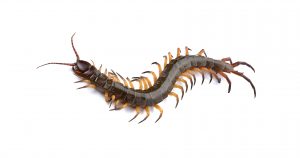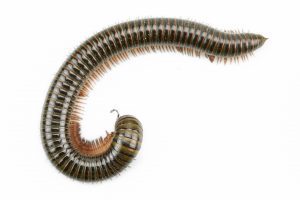

Centipedes and millipedes are common household pests with wormlike bodies. The two can be difficult to tell apart; however, the shape of their bodies and the arrangement of their legs are very different.
In this article, we will review how to identify centipedes vs millipedes, why you might find millipedes and centipedes in your house, and how to get rid of them.
How Do I Identify Centipedes vs Millipedes?
While centipedes and millipedes may look similar at first glance, upon closer inspection they are very different. Neither species has one hundred or one thousand legs as their names imply, but they do have a lot of legs. One of their major differences is in the position of those legs.
Centipedes have a pair of legs per segment, while millipedes have two. Additionally, most centipedes have flattened bodies, while millipedes have more volume dorsoventrally.
Another word of caution when it comes to the difference between millipedes and centipedes is that centipedes may bite. They are known for eating other bugs and can bite when they feel threatened.
Why Are Centipedes and Millipedes in My House?
Centipedes and millipedes are common pests in the Washington D. C. area, especially in the summer. These bugs need moisture and usually, live outdoors in wet leaf litter and moist ground. However, in the hotter, drier months, they may go searching for a more suitable habitat than the outdoors which can lead them straight to your house.
Centipedes and millipedes will take advantage of any foundational cracks, unsealed openings, or open windows to invade your house and seek out moisture. They are most commonly found in kitchens and bathrooms where the majority of the moisture in your house resides.
Opposite to dry conditions, extreme moisture outdoors such as heavy rains can also drive centipedes and millipedes indoors to take shelter from the excessive water that can drown them.
How Do I Get Rid them?
The best offense against centipedes and millipedes is a good defense. Before centipedes and millipedes become a problem or even after they have, you need to ensure that no more will get in. Seal up any cracks or vulnerable spots in the foundation or ground level of your home.
Place dehumidifiers in the basement and other rooms that tend to collect moisture. Centipedes and millipedes also tend to hide in cardboard boxes so make sure to store these away from the ground in a dry room.
You can use household pesticides to spray areas that you know the millipedes and centipedes inhabit or spray the bugs directly. If you would rather take a non-chemical approach to millipede and centipede disposal, vacuum up the bugs as you find them.
If you would rather not deal with eradicating the critters on your own, call My Pest Pros, your local pest control company. My Pest Pros has served the Northern Virginia and Maryland area for years. Our pest experts can eliminate millipede and centipede problems in your home and protect your family from these and other pests from returning.